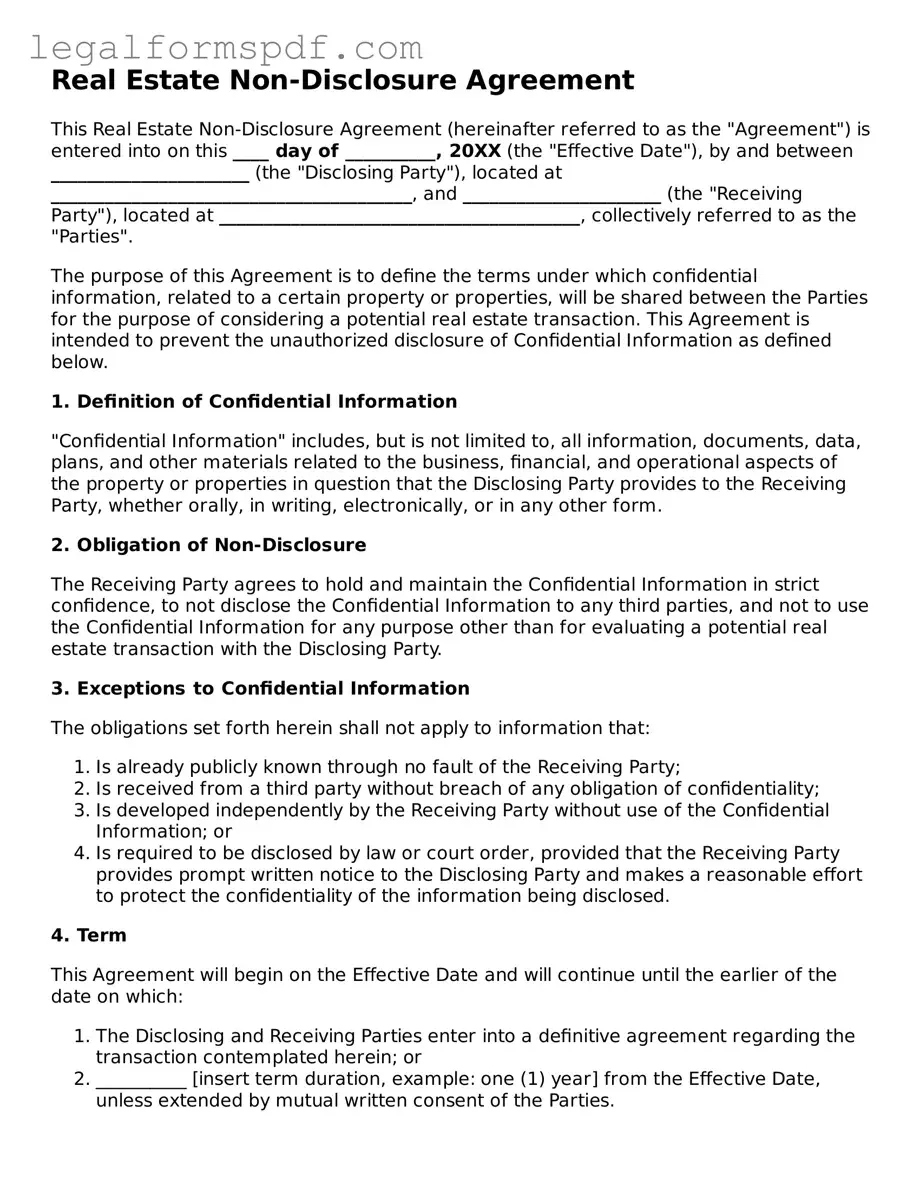Real Estate Non-Disclosure Agreement
This Real Estate Non-Disclosure Agreement (hereinafter referred to as the "Agreement") is entered into on this ____ day of __________, 20XX (the "Effective Date"), by and between ______________________ (the "Disclosing Party"), located at ________________________________________, and ______________________ (the "Receiving Party"), located at ________________________________________, collectively referred to as the "Parties".
The purpose of this Agreement is to define the terms under which confidential information, related to a certain property or properties, will be shared between the Parties for the purpose of considering a potential real estate transaction. This Agreement is intended to prevent the unauthorized disclosure of Confidential Information as defined below.
1. Definition of Confidential Information
"Confidential Information" includes, but is not limited to, all information, documents, data, plans, and other materials related to the business, financial, and operational aspects of the property or properties in question that the Disclosing Party provides to the Receiving Party, whether orally, in writing, electronically, or in any other form.
2. Obligation of Non-Disclosure
The Receiving Party agrees to hold and maintain the Confidential Information in strict confidence, to not disclose the Confidential Information to any third parties, and not to use the Confidential Information for any purpose other than for evaluating a potential real estate transaction with the Disclosing Party.
3. Exceptions to Confidential Information
The obligations set forth herein shall not apply to information that:
- Is already publicly known through no fault of the Receiving Party;
- Is received from a third party without breach of any obligation of confidentiality;
- Is developed independently by the Receiving Party without use of the Confidential Information; or
- Is required to be disclosed by law or court order, provided that the Receiving Party provides prompt written notice to the Disclosing Party and makes a reasonable effort to protect the confidentiality of the information being disclosed.
4. Term
This Agreement will begin on the Effective Date and will continue until the earlier of the date on which:
- The Disclosing and Receiving Parties enter into a definitive agreement regarding the transaction contemplated herein; or
- __________ [insert term duration, example: one (1) year] from the Effective Date, unless extended by mutual written consent of the Parties.
5. Return of Confidential Information
Upon the request of the Disclosing Party, the Receiving Party agrees to promptly return or destroy all copies of Confidential Information received under this Agreement, including all notes, summaries, and other derivative materials prepared by the Receiving Party.
6. Jurisdiction and Disputes
This Agreement shall be governed by and construed in accordance with the laws of the state of __________, without regard to its conflict of laws provisions. Any disputes under this Agreement shall be resolved in the state or federal courts located in __________ County, __________.
7. Entire Agreement
This Agreement constitutes the entire agreement between the Parties with respect to its subject matter and supersedes all prior and contemporaneous agreements and understandings, whether oral or written, between the Parties concerning the subject matter hereof.
IN WITNESS WHEREOF, the Parties have executed this Real Estate Non-Disclosure Agreement as of the Effective Date first above written.
Disclosing Party: ___________________________________
Signature: ___________________________________
Date: ___________________________________
Receiving Party: ___________________________________
Signature: ___________________________________
Date: ___________________________________
